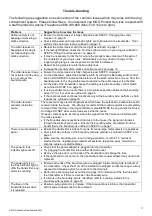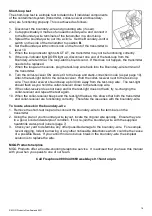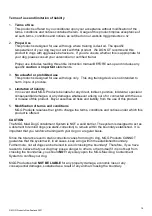
12
© MGG Products New Zealand 2021
•
Place the boundary-wire carefully into the slit maintaining some slack to allow for expansion and
contraction with temperature variations
•
Carefully secure the boundary-wire into the slit using a blunt tool such as a wooden spatula to
avoid damaging the wire
Crossing hard surfaces / driveways
(7D)
•
Place the boundary-wire in a convenient expansion
slot or create a groove using a circular saw and
masonry blade
•
For best results, clean out with a brush any dust or
debris before inserting the wire
•
Cover with an appropriate patching compound, such
as a bead of silicone
Crossing a gravel or dirt driveway
(7E)
Place the boundary-wire in a PVC pipe or water hose to
protect the wire before burying.
STEP 8:
Placing the boundary training flags
During the training period, the boundary training flags are useful visual reminders for your dog of
where the static-correction zone lies. Place the flags as follows:
•
Hold the collar-receiver by the strap at the height
of your dog’s neck
•
Walk towards the static-correction zone until the
collar-receiver beeps (
8A
).
•
Place a boundary training flag in the ground (
8B
).
•
Walk back into the dog containment area until the
beeping stops
•
Repeat this process around the entire perimeter of
the dog containment area until it is marked with
boundary training flags approximately every 3
metres
With the boundary-wire fully installed, the collar-receiver tested and static-correction zone marked
with training flags, it is time to introduce your dog to the system.
STEP 9:
Fitting the collar-receiver
Careful and correct placement of the collar-receiver is important for both training and effective use
of the dog containment system. The collar-receiver should be placed as follows:
1. Before starting, the transmitter must be turned OFF
2. Start with your dog standing comfortably (not sitting) (
9A
)
3. Centre the prongs on the underside of your dog
’s neck. The prongs need to make direct
contact with the skin. Trimming of the fur will be required in longer-haired dog breeds, to
achieve this
4. Check the tightness of the collar-strap by
inserting one finger between the collar
and your dog
’s neck. The fit should be
snug but not constricting (
9B
)
5. Allow your dog to wear the collar-
receiver for several minutes, then
recheck the fit. This should be repeated
as your dog becomes more comfortable
with the collar-receiver




















